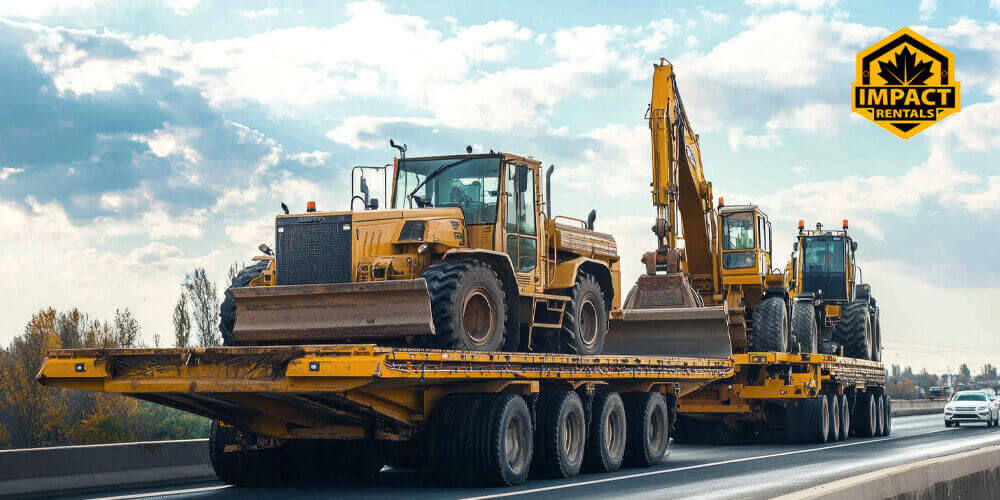
How to Transport Earthmoving Equipment?
Earthmoving equipment is widely used in various industries. Transportation of this equipment is important and challenging. Big machines like bulldozers, excavators, and wheel loaders are required to do many jobs on construction sites and mines. It’s important to move these machines safely and efficiently to keep projects running smoothly. In this article, we will explore how to transport earthmoving equipment and what is needed to transport it properly.
Challenges of Heavy Equipment Transportation
The transportation of heavy earthmoving equipment has several challenges. Each of them is mentioned below:
Safety
Safety is the first priority when handling any equipment. It is essential for the driver’s safety and those near or working around it. The staff should be qualified enough to load and unload the equipment safely.
Rules and Regulations
The transportation of heavy vehicles must follow strict rules. Fleet managers and drivers must understand the rules to avoid serious accidents. If you are unaware of the rules that apply to heavy equipment, it can end up very costly. The Department of Transportation may oversee overhauling; each state has its own set of rules. Most states need a special heavy haul permit, but the overweight limits may change from one place to another.
There are also different rules regarding warning signs, flags, escort vehicles, and the type of truck to be used depending on the load, weight, and route. Companies that move heavy equipment must also be licensed and carry proper insurance for both liability and cargo.
Planning Logistics
Fleet managers need to consider safety and follow the rules when planning routes for heavy loads. Make sure that the company has the right trucks to do the job, like a flatbed truck, which can do most of the jobs. You need highly skilled workers to load and unload the equipment safely. The driver’s experience also matters, especially when you are planning their hours on the road.
Safety Tips While Loading and Unloading Earth Moving Equipment
Loading and unloading the earthmoving equipment is dangerous, and we must follow safety precautions at every step. We have provided some tips for you.
Loading the Equipment
- Prioritise teamwork
- Assign responsibilities to every team member
- Make sure that the ramp and trailer are clean from materials like oil, grease, and dirt.
- Clear the loading area.
- Ensure proper alignment of the equipment with the ramp
- Tie the equipment with tight chains to avoid movements or bounces during transportation.
Unloading the Equipment
- Clear the area where you are going to position the equipment
- Set up the loading ramp on a stable surface
- Remove the chains from the equipment
- Carefully back the machine down the ramp
- Once the equipment is on the ground, inspect it thoroughly to ensure there’s no damage from the unloading process.
Safe Transportation of Earth Moving Equipment
Every year, accidents involving heavy trucks and cargo transport lead to injuries and even deaths. Such incidents make us realize the importance of safety, training, and rules and regulations during transportation. We have a few of them for you!
1. Plan the Best Route Map
Prior planning of your route is crucial to moving earthmoving equipment. It ensures that there are no accidents, like getting stuck under a low overpass. Check the road width and analyze the bridge’s condition to find the safest path. If the route is more challenging with more turns, speed breakers, stops, starts, and so on, it may be safer to transport the equipment. So, plan a route check before the start and ensure you have the best route for safe transportation.
2. Apply for a Transportation Permit
Most earthmoving equipment exceeds the load limits and sizes, which can add more liability for us. So, disassemble the equipment into smaller parts and avoid oversized designations. Apply for proper permits from the beginning and adhere to their regulations to avoid fines, delays, and safety risks
3. Secure the Equipment Wheels
It may take time, but the added safety is worth it. Apply the equipment’s parking brakes. Use wedges, chocks, or cradles to lock the wheels and ensure that the equipment doesn’t move during transportation. Double-check for machine-specific loading or transport instructions in the manufacturer’s manual or spec sheet.
4. Ensure Safety Signs, Labels, and Lights are Fixed to Your Equipment
You might have noticed some lights, banners, caution boards, and many lights on oversized loads. These additions will alert the drivers to take extra caution while approaching or passing by the vehicle. You need to have one or more escort vehicles to help other drivers and lower the risk of accidents.
5. Perform Regular Inspections
Safe and legal heavy cargo transport doesn’t stop once the engine starts. While your equipment is on the road, especially during long trips, it’s important to stop regularly to check on everything. Ensure the load is secure, the equipment hasn’t moved, and nothing is damaged. These quick inspections help catch problems early and keep the trip running smoothly and safely.
Common Mistakes to Avoid When Transporting
- Unable to assess the equipment’s dimensions properly.
- Not securing equipment parts and loose components
- Ignoring route planning
- Not obeying clearances and weight restrictions.
- Unable to comply with legal and permit requirements
- Delayed Deliveries
Contact Impact Rentals for Heavy Equipment
Transporting heavy earthmoving equipment needs careful planning, proper transport methods, and adherence to laws and regulations. Since each type of equipment is different, securing it properly and using an approach that fits the equipment is important. Taking these steps helps ensure a safe and efficient transportation. Whether you’re hauling excavators, dozers, or cranes at Impact Rentals, our team is trained to handle the complexities of heavy transport from start to finish. We provide well-maintained heavy equipment with on-site pickup and delivery options for your project. Contact us today to get started!